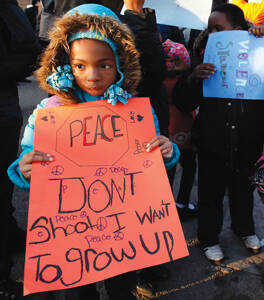More than 200 children and adults gathered on a street corner on Chicago’s South Side on Nov. 30 to pray for peace on their streets. Earlier that week, shots rang out at nearby St. Columbanus Church following the funeral of a reputed gang member. One man was killed and another injured in the shooting. Catholic and other Christian pastors organized the prayer service, march and concert because the man whose funeral the mourners were attending was a member of their community and was himself struck down violently.
Eleven more shootings occurred on the evening of Dec. 3 and into the next morning. So far in 2012, homicides in Chicago have risen to 480, a 21 percent increase from 2011’s 398 homicides. If the trend continues, this year the city will likely exceed 500 homicides for the first time since 2008. In a metropolitan area rocked by crime, Chicago-area Catholics are being challenged to respond.
The metro area’s streak of violence, however, encompasses far more than the headline-grabbing homicide totals. From armed robberies and home invasions to child abuse and domestic assaults, violence in Chicago touches all races, ethnicities, socioeconomic groups and faiths, affecting all facets of community and family life. Catholics, many local faith leaders contend, should have a leading role in combating the grim realities of urban violence.
Earlier this year, the Rev. Michael Pfleger, pastor of St. Sabina Parish, was named the archdiocesan representative for newly developing anti-violence initiatives. He has consistently urged Chicago-area Catholics to be “lobbyists against violence.”
“Among all the great gifts Jesus gave us, he chose to give us the gift of peace,” Father Pfleger said. “Our responsibility is to share peace and lift it up.”
Last October, in a steady rain, Carl Quebedeaux, C.M.F., marched a group of more than 200 people down the streets of Chicago’s Southeast Side. Together, the group—predominantly parishioners from four South Side parishes—prayed for a more peaceful community, lit candles in memory of neighbors who had died as a result of violent acts and reflected on the individual and collective roles they might play in constructing peace.
The traveling group stopped at an intersection dubbed “Death Corner.” There Father Quebedeaux, pastor of Our Lady of Guadalupe Church, blessed the intersection and, borrowing a Native American tradition, offered prayers in four directions. The march then carried on, concluding with a Mass at the Church of Our Lady of Guadalupe, where participants made a public pledge to create peaceful environments and protect the gift of life.
“It was an effort to join in prayer, to build community and to awaken the courage to resist violence in our communities and our homes,” Father Quebedeaux said. “There’s a tendency to grow numb and say, ‘Violence isn’t my problem,’ but this is something we’re all involved in.”
Father Pfleger, meanwhile, continues pushing for solutions that will curb violence and promote tolerance and respect. He has called for church-led workshops teaching conflict resolution, sponsored a petition calling for the banning of assault weapons and urged his fellow priests to preach about the need for Catholics to fill peacemaking roles.
“There’s an unraveling of society and we need to counteract this,” Father Pfleger said. “Peace has to be created—that’s our job as Catholics and Christians.”








